Doctor Curmudgeon® Seven Names
By Diane Batshaw Eisman, M.D. FAAP Doctor Eisman is in Family Practice in Aventura, Florida with her partner, Dr. Eugene Eisman, an internist/cardiologist
There are seven names that should not be forgotten:
Edna Sutton
Missouria Louvinia Meadows-Walker
Clemmie Phillips
Phyllis Alfreda Hall Lambert
Marjorie Tucker Reed
Kate Gillespie
Virginia Allen
These are the names of seven of the courageous Black women who were nurses. These women, known as the “Black Angels” served in the front lines of a devastating pandemic.
There were about three hundred “Black Angels” in all.
Without these trail blazing nurses, the “Great White Plague” of tuberculosis would have killed more people.
Once upon a time in 1929, there was a hospital on Staten Island called Sea View. Because of segregation it was only staffed by white nurses. It was not an easy place for a nurse to provide health care. There was never enough staff or enough money for supplies and medicine.
This hospital was high up on a hill and many miles from the Manhattan ferry. Maria Smilios, the author of The Black Angels: The Untold Story of the Nurses Who helped Cure Tuberculosis writes on the nurse.org website: “Inside its wards, thousands of patients, mostly immigrants, Black people and those on the fringes of society, lay languishing, waiting to die.”
In the first half of the twentieth century, tuberculosis had already killed about 5.6 million Americans. There was no cure.
Nurses had a difficult five hour round trip journey from Manhattan to Sea View on Staten Island,
They provided what care they could at the hospital. But they could only watch helplessly as patients and colleagues died.
The white nurses at Sea View Hospital fled from this terrifying scourge in 1929. The hospital could not stay open; without nursing care. Patients who were infected would be turned out onto the street. More deaths would occur. A catastrophe!
Very few hospitals hired Black nurses. New York City was frantic to find qualified nurses who would care for tuberculosis patients.
In desperation, city officials began to look across the Mason-Dixon Line for Black nurses. They were offered housing, education and higher pay. They would be able to escape from the discrimination in the South.
Sea View was now staffed by Black nurses—gallant women who labored to give care to patients who frequently abused them. They were even taunted by the residents on Staten Island.
Although subjected to sexism and racism, the Black Angels carried on their professional work. They consoled and nursed their patients amidst a horrible disease without a cure.
And then in 1952 it happened: Isoniazid arrived.
Drs. Edward Robitzek and Irving J. Selikoff were investigating Isoniazid. It appeared that the compound could stop the growth of the bacterium that caused Tuberculosis.
They needed clinical trials.
It was the Black Angels, the nurses at Sea View who stepped in.
They administered the medication, carefully observed the patients and meticulously reported their results.
The Staten Island Museum website acknowledges that “Patients, who months before had been condemned to spend their remaining years in hospital wards, were bheing discharged hving been cured of infection. Others whose active infection had prevented surgery to repair their damaged lungs were no eligible for the procedures.”
Dr. Rolbitzek said, “Had it not been for the Black nurses none of this (Tithe trial) would have been possible.”
My humble thanks to the trail blazing women of the Black Angels.
My thanks to enbastet for the idea for this column.
Click Here to Order Boxing Interviews Of A Lifetime By “Bad” Brad Berkwitt


